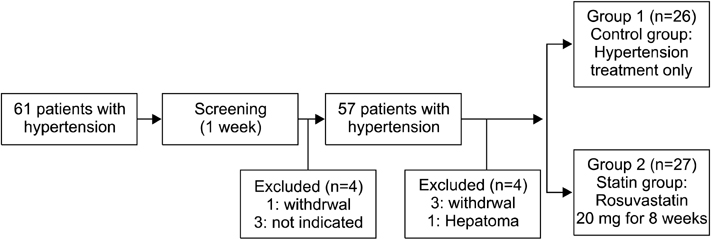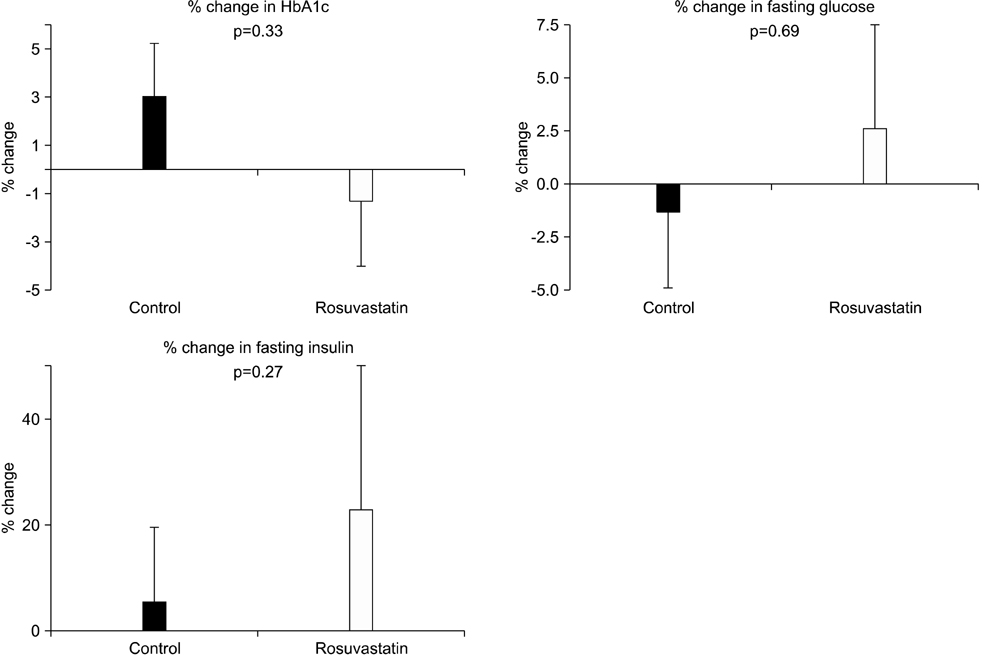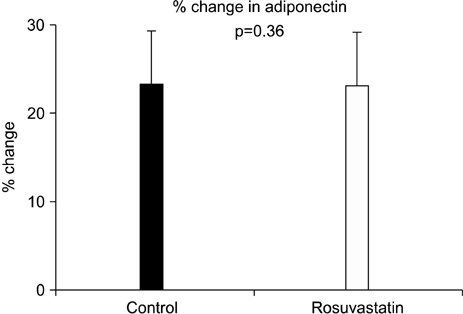Chonnam Med J.
2013 Apr;49(1):31-37. 10.4068/cmj.2013.49.1.31.
Rosuvastatin Does Not Affect Fasting Glucose, Insulin Resistance, or Adiponectin in Patients with Mild to Moderate Hypertension
- Affiliations
-
- 1Cardiology Division, Department of Internal Medicine, Kyung Hee University School of Medicine, Seoul, Korea.
- 2Cardiovascular Center, Gwangju Veterans Hospital, Gwangju, Korea. kvhwkim@chol.com
- KMID: 2172174
- DOI: http://doi.org/10.4068/cmj.2013.49.1.31
Abstract
- The effects of statins on insulin resistance and new-onset diabetes are unclear. The purpose of this study was to evaluate the effects of rosuvastatin on insulin resistance and adiponectin in patients with mild to moderate hypertension. In a randomized, prospective, single-blind study, 53 hypertensive patients were randomly assigned to the control group (n=26) or the rosuvastatin (20 mg once daily) group (n=27) during an 8-week treatment period. Both groups showed significant improvements in systolic blood pressure and flow-mediated dilation (FMD) after 8 weeks of treatment. Rosuvastatin treatment improved total cholesterol, low-density lipoprotein (LDL)-cholesterol, and triglyceride levels. The control and rosuvastatin treatment groups did not differ significantly in the change in HbA1c (3.0+/-10.1% vs. -1.3+/-12.7%; p=0.33), fasting glucose (-1.3+/-18.0% vs. 2.5+/-24.1%; p=0.69), or fasting insulin levels (5.2+/-70.5% vs. 22.6+/-133.2%; p=0.27) from baseline. Furthermore, the control and rosuvastatin treatment groups did not differ significantly in the change in the QUICKI insulin sensitivity index (mean change, 2.2+/-11.6% vs. 3.6+/-11.9%; p=0.64) or the HOMA index (11.6+/-94.9% vs. 32.4+/-176.7%; p=0.44). The plasma adiponectin level increased significantly in the rosuvastatin treatment group (p=0.046), but did not differ significantly from that in the control group (mean change, 23.2+/-28.4% vs. 23.1+/-27.6%; p=0.36). Eight weeks of rosuvastatin (20 mg) therapy resulted in no significant improvement or deterioration in fasting glucose levels, insulin resistance, or adiponectin levels in patients with mild to moderate hypertension.
Keyword
MeSH Terms
-
Adiponectin
Blood Glucose
Blood Pressure
Cholesterol
Fasting
Fluorobenzenes
Glucose
Humans
Hydroxymethylglutaryl-CoA Reductase Inhibitors
Hypertension
Insulin
Insulin Resistance
Lipoproteins
Plasma
Prospective Studies
Pyrimidines
Single-Blind Method
Sulfonamides
Rosuvastatin Calcium
Adiponectin
Blood Glucose
Cholesterol
Fluorobenzenes
Glucose
Hydroxymethylglutaryl-CoA Reductase Inhibitors
Insulin
Lipoproteins
Pyrimidines
Sulfonamides
Figure
Reference
-
1. Han SH, Quon MJ, Koh KK. Reciprocal relationships between abnormal metabolic parameters and endothelial dysfunction. Curr Opin Lipidol. 2007. 18:58–65.
Article2. Chalmers J, MacMahon S, Mancia G, Whitworth J, Beilin L, Hansson L, et al. 1999 World Health Organization-International Society of Hypertension Guidelines for the management of hypertension. Guidelines sub-committee of the World Health Organization. Clin Exp Hypertens. 1999. 21:1009–1060.3. Ridker PM, Danielson E, Fonseca FA, Genest J, Gotto AM Jr, Kastelein JJ, et al. JUPITER Study Group. Rosuvastatin to prevent vascular events in men and women with elevated C-reactive protein. N Engl J Med. 2008. 359:2195–2207.
Article4. Koh KK. Effects of statins on vascular wall: vasomotor function, inflammation, and plaque stability. Cardiovasc Res. 2000. 47:648–657.
Article5. Koh KK, Quon MJ, Han SH, Ahn JY, Jin DK, Kim HS, et al. Vascular and metabolic effects of combined therapy with ramipril and simvastatin in patients with type 2 diabetes. Hypertension. 2005. 45:1088–1093.
Article6. Huptas S, Geiss HC, Otto C, Parhofer KG. Effect of atorvastatin (10 mg/day) on glucose metabolism in patients with the metabolic syndrome. Am J Cardiol. 2006. 98:66–69.
Article7. Takarada S, Imanishi T, Ishibashi K, Tanimoto T, Komukai K, Ino Y, et al. The effect of lipid and inflammatory profiles on the morphological changes of lipid-rich plaques in patients with non-ST-segment elevated acute coronary syndrome: follow-up study by optical coherence tomography and intravascular ultrasound. JACC Cardiovasc Interv. 2010. 3:766–772.
Article8. Katsiki N, Tziomalos K, Chatzizisis Y, Elisaf M, Hatzitolios AI. Effect of HMG-CoA reductase inhibitors on vascular cell apoptosis: beneficial or detrimental? Atherosclerosis. 2010. 211:9–14.
Article9. Collins R, Armitage J, Parish S, Sleigh P, Peto R. Heart Protection Study Collaborative Group. MRC/BHF Heart Protection Study of cholesterol-lowering with simvastatin in 5963 people with diabetes: a randomised placebo-controlled trial. Lancet. 2003. 361:2005–2016.
Article10. Sever PS, Dahlöf B, Poulter NR, Wedel H, Beevers G, Caulfield M, et al. ASCOT investigators. Preventionof coronary and stroke events with atorvastatin in hypertensive patients who have average or lower-than-average cholesterol concentrations, in the Anglo-Scandinavian Cardiac Outcomes Trial--Lipid Lowering Arm (ASCOT-LLA): a multicentre randomised controlled trial. Lancet. 2003. 361:1149–1158.
Article11. Koh KK, Quon MJ, Han SH, Lee Y, Kim SJ, Shin EK. Atorvastatin causes insulin resistance and increases ambient glycemia in hypercholesterolemic patients. J Am Coll Cardiol. 2010. 55:1209–1216.
Article12. Devaraj S, Siegel D, Jialal I. Simvastatin (40 mg/day), adiponectin levels, and insulin sensitivity in subjects with the metabolic syndrome. Am J Cardiol. 2007. 100:1397–1399.
Article13. Kim W, Jeong MH, Cho SH, Yun JH, Chae HJ, Ahn YK, et al. Effect of green tea consumption on endothelial function and circulating endothelial progenitor cells in chronic smokers. Circ J. 2006. 70:1052–1057.
Article14. Park CS, Kim W, Woo JS, Ha SJ, Kang WY, Hwang SH, et al. Green tea consumption improves endothelial function but not circulating endothelial progenitor cells in patients with chronic renal failure. Int J Cardiol. 2010. 145:261–262.
Article15. Kumada M, Kihara S, Sumitsuji S, Kawamoto T, Matsumoto S, Ouchi N, et al. Osaka CAD Study Group. Coronary artery disease. Association of hypoadiponectinemia with coronary artery disease in men. Arterioscler Thromb Vasc Biol. 2003. 23:85–89.16. Grundy SM, Hansen B, Smith SC Jr, Cleeman JI, Kahn RA; American Heart Association; National Heart, Lung, and Blood Institute; American Diabetes Association. Clinical management of metabolic syndrome: report of the American Heart Association/National Heart, Lung, and Blood Institute/American Diabetes Association conference on scientific issues related to management. Circulation. 2004. 109:551–556.17. Saad MF, Rewers M, Selby J, Howard G, Jinagouda S, Fahmi S, et al. Insulin resistance and hypertension: the Insulin Resistance Atherosclerosis study. Hypertension. 2004. 43:1324–1331.18. Diabetes Prevention Program Research Group. Hypertension, insulin, and proinsulin in participants with impaired glucose tolerance. Hypertension. 2002. 40:679–686.19. Mitchell BD, Haffner SM, Hazuda HP, Valdez R, Stern MP. The relation between serum insulin levels and 8-year changes in lipid, lipoprotein, and blood pressure levels. Am J Epidemiol. 1992. 136:12–22.
Article20. Koh KK, Quon MJ, Han SH, Lee Y, Ahn JY, Kim SJ, et al. Simvastatin improves flow-mediated dilation but reduces adiponectin levels and insulin sensitivity in hypercholesterolemic patients. Diabetes Care. 2008. 31:776–782.
Article21. Koh KK, Quon MJ, Sakuma I, Han SH, Choi H, Lee K, et al. Differential metabolic effects of rosuvastatin and pravastatin in hypercholesterolemic patients. Int J Cardiol. 2011. [Epub ahead of print].
Article22. Keech A, Colquhoun D, Best J, Kirby A, Simes RJ, Hunt D, et al. LIPID Study Group. Secondary prevention of cardiovascular events with long-term pravastatin in patients with diabetes or impaired fasting glucose: results from the LIPID trial. Diabetes Care. 2003. 26:2713–2721.
Article23. Freeman DJ, Norrie J, Sattar N, Neely RD, Cobbe SM, Ford I, et al. Pravastatin and the development of diabetes mellitus: evidence for a protective treatment effect in the West of Scotland Coronary Prevention Study. Circulation. 2001. 103:357–362.
Article24. Park JS, Kim YJ, Choi JY, Kim YN, Hong TJ, Kim DS, et al. Comparative study of low doses of rosuvastatin and atorvastatin on lipid and glycemic control in patients with metabolic syndrome and hypercholesterolemia. Korean J Intern Med. 2010. 25:27–35.
Article25. Coleman CI, Reinhart K, Kluger J, White CM. The effect of statins on the development of new-onset type 2 diabetes: a meta-analysis of randomized controlled trials. Curr Med Res Opin. 2008. 24:1359–1362.
Article26. Naples M, Federico LM, Xu E, Nelken J, Adeli K. Effect of rosuvastatin on insulin sensitivity in an animal model of insulin resistance: evidence for statin-induced hepatic insulin sensitization. Atherosclerosis. 2008. 198:94–103.
Article27. Taneva E, Borucki K, Wiens L, Makarova R, Schmidt-Lucke C, Luley C, et al. Early effects on endothelial function of atorvastatin 40 mg twice daily and its withdrawal. Am J Cardiol. 2006. 97:1002–1006.
Article
- Full Text Links
- Actions
-
Cited
- CITED
-
- Close
- Share
- Similar articles
-
- A Study of Serum Adiponectin and Insulin Resistance in Children and Adolescents
- Serum Adiponectin Levels and Insulin Resistance in Obese Children
- Association of Serum Adiponectin Levels with Insulin Resistance in Women with Polycystic Ovary Syndrome
- The Relation of Serum Adiponectin and Resistin Concentrations with Metabolic Risk Factors
- Adiponectin in Women with Polycystic Ovary Syndrome





